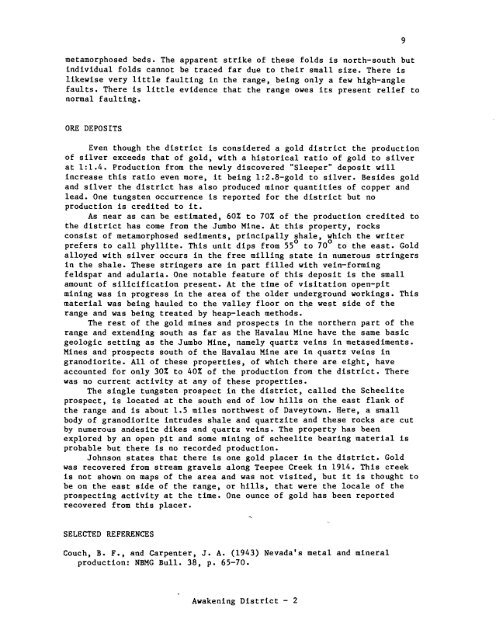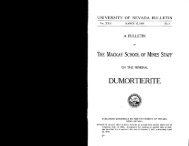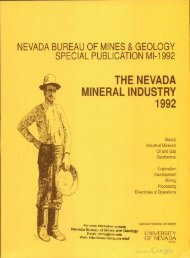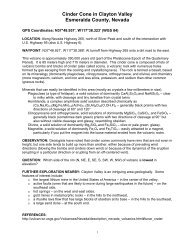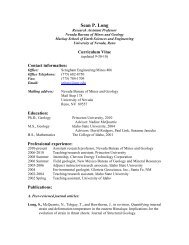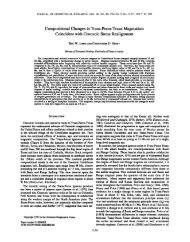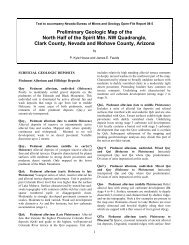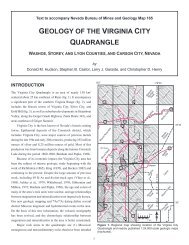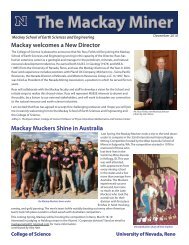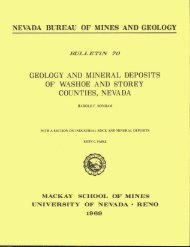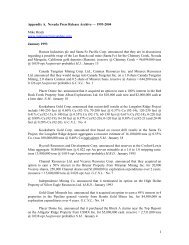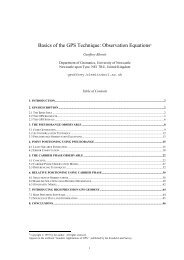Nevada Bureau of Mines and Geology - University of Nevada, Reno
Nevada Bureau of Mines and Geology - University of Nevada, Reno
Nevada Bureau of Mines and Geology - University of Nevada, Reno
You also want an ePaper? Increase the reach of your titles
YUMPU automatically turns print PDFs into web optimized ePapers that Google loves.
metamorphosed beds. The apparent strike <strong>of</strong> these folds is north-south but<br />
individual folds cannot be traced far due to their small size. There is<br />
likewise very little faulting in the range, being only a few high-angle<br />
faults. There is little evidence that the range owes its present relief to<br />
normal faulting.<br />
ORE DEPOSITS<br />
Even though the district is considered a gold district the production<br />
<strong>of</strong> silver exceeds that <strong>of</strong> gold, with a historical ratio <strong>of</strong> gold to silver<br />
at 1:1.4. Production from the newly discovered "Sleeper" deposit will<br />
increase this ratio even more, it being 1:2.8-gold to silver. Besides gold<br />
<strong>and</strong> silver the district has also produced minor quantities <strong>of</strong> copper <strong>and</strong><br />
lead. One tungsten occurrence is reported for the district but no<br />
production is credited to it.<br />
As near as can be estimated, 60% to 70% <strong>of</strong> the production credited to<br />
the district has come from the Jumbo Mine. At this property, rocks<br />
consist <strong>of</strong> metamorphosed sediments, principally shale, which the writer<br />
0<br />
prefers to call phyllite. This unit dips from 55' to 70 to the east. Gold<br />
alloyed with silver occurs in the free milling state in numerous stringers<br />
in the shale. These stringers are in part filled with vein-forming<br />
feldspar <strong>and</strong> adularia. One notable feature <strong>of</strong> this deposit is the small<br />
amount <strong>of</strong> silicification present. At the time <strong>of</strong> visitation open-pit<br />
mining was in progress in the area <strong>of</strong> the older underground workings. This<br />
material was being hauled to the valley floor on the west side <strong>of</strong> the<br />
range <strong>and</strong> was being treated by heap-leach methods.<br />
The rest <strong>of</strong> the gold mines <strong>and</strong> prospects in the northern part <strong>of</strong> the<br />
range <strong>and</strong> extending south as far as the Havalau Mine have the same basic<br />
geologic setting as the Jumbo Mine, namely quartz veins in metasediments.<br />
<strong>Mines</strong> <strong>and</strong> prospects south <strong>of</strong> the Havalau Mine are in quartz veins in<br />
granodiorite. All <strong>of</strong> these properties, <strong>of</strong> which there are eight, have<br />
accounted for only 30% to 40% <strong>of</strong> the production from the district. There<br />
was no current activity at any <strong>of</strong> these properties.<br />
The single tungsten prospect in the district, called the Scheelite<br />
prospect, is located at the south end <strong>of</strong> low hills on the east flank <strong>of</strong><br />
the range <strong>and</strong> is about 1.5 miles northwest <strong>of</strong> Daveytown. Here, a small<br />
body <strong>of</strong> granodiorite intrudes shale <strong>and</strong> quartzite <strong>and</strong> these rocks are cut<br />
by numerous <strong>and</strong>esite dikes <strong>and</strong> quartz veins. The property has been<br />
explored by an open pit <strong>and</strong> some mining <strong>of</strong> scheelite bearing material is<br />
probable but there is no recorded production.<br />
Johnson states that there is one gold placer in the district. Gold<br />
was recovered from stream gravels along Teepee Creek in 1914. This creek<br />
is not shown on maps <strong>of</strong> the area <strong>and</strong> was not visited, but it is thought to<br />
be on the east side <strong>of</strong> the range, or hills, that were the locale <strong>of</strong> the<br />
prospecting activity at the time. One ounce <strong>of</strong> gold has been reported<br />
recovered from this placer.<br />
SELECTED REFERENCES<br />
Couch, B. F., <strong>and</strong> Carpenter, J. A. (1943) <strong>Nevada</strong>'s metal <strong>and</strong> mineral<br />
production: NBMG Bull. 38, p. 65-70.<br />
Awakening District - 2


